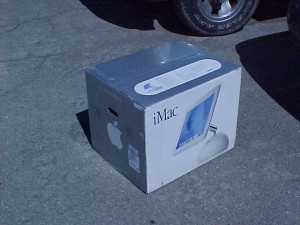Just over a decade ago I started my college’s computer science program. I’d always loved computers; I remember the days playing games on the computer of my best friend who lived down the street, before my family bought one of our own. Once we did, I remember writing stories on some old DOS software and then finally venturing into the world of Windows 3.1 and Windows 95.

I was rather late to the Mac owners’ guild, at least by my friends’ standards; I started with one of the Luxo Jr.-style iMac G4s with the round base and the flat panel in April 2002, during my first year of college. Now of course I’d used Macs before I’d entered college; some of my first experiences with computers were on Apple IIe boxes in my elementary school’s computer lab, playing really basic games in green pixels on a black screen with nothing but a 5 1/4″ floppy drive. Through middle and high school I worked on a bunch of computers through my school’s technology clubs and programs, and for my junior and senior year in high school, I took some time in an independent study to refurbish Power Macintoshes with a goal of supplying each classroom in the building with a computer with OS 7.6. Through this love of tinkering, I entered college thinking computer science was a natural choice. I still use the concepts I learned in those first C++ classes every day.
The big shift
But after I set that iMac on my dorm room’s desk, something happened. I started looking at more than just the code. I studied how things looked and worked. If it didn’t make sense, I wasn’t happy with it. It wasn’t enough for me to go from point A to point B in a program – you had to get there well. You had to get there and enjoy the experience. Now of course, this kind of thing didn’t make sense to a lot of the computer people around me at the time; computers are supposed to help us get something done, so who cares how it works as long as it works?
Eventually I switched to new media to investigate some of these other facets of technology, and I ended up graduating with a degree in new media and minors in computer science and psychology.
I never noticed it until a few days ago, but there’s a strange correlation between the time I’ve used Macs and the time I studied design, usability, and how technology feels. And though I’m still technically a coder both by title and occupation, my true love has really grown into this analysis of how things work, how they’re used, and in a similar vein, how we can use technology to do things we’d never imagined possible.
Time travel
I have no real interest in time travel. I doesn’t really care to see what life was like when dinosaurs roamed the earth, and I don’t really want to see how life will be two hundred or a thousand years from now. I like living where I am and seeing where it goes on its own. But if there’s one journey I’d make, I’d take my iPad back to around 1950. I’d like to show those people what we can do: the power we hold in our hands with a magical web that connects all of us, and this device I hold in my hands. I’d show them that this machine, lighter than most books, can access an almost infinite amount of information as well as being used for drawing, used for reading, used to hear and see entertainment, used to see a friend’s face in real time from across the country or the world. I’d like to see their reaction, and I’d want them to guess the time from which I came. I think a lot of them might expect the 2300s or 2400s. I’d love to see what they would say when I told them we’d have all this power, all this possibility, in our hands in less than a century.
Now of course, Steve Jobs isn’t solely responsibly for my shift to design and usability, and he’s not solely responsible for the technology we hold in our hands that would baffle and mystify those living just a few decades ago. But more than any other single person, Steve showed us that it’s good to push the expectations of what is necessary and possible.
I respected a lot about Steve. I respected his taste, his refinement, his eye for a good idea. I loved the way he thought through a product and wasn’t satisfied with anything less than the best.
I’m just glad I was alive to see everything that’s happened over the last decade, and I’m excited to see where we go next. Above all, it’s safe to say that if there’s one person in my lifetime I see as an inspiration, it’s Steve. Thanks for all you did, both for the world and for me.